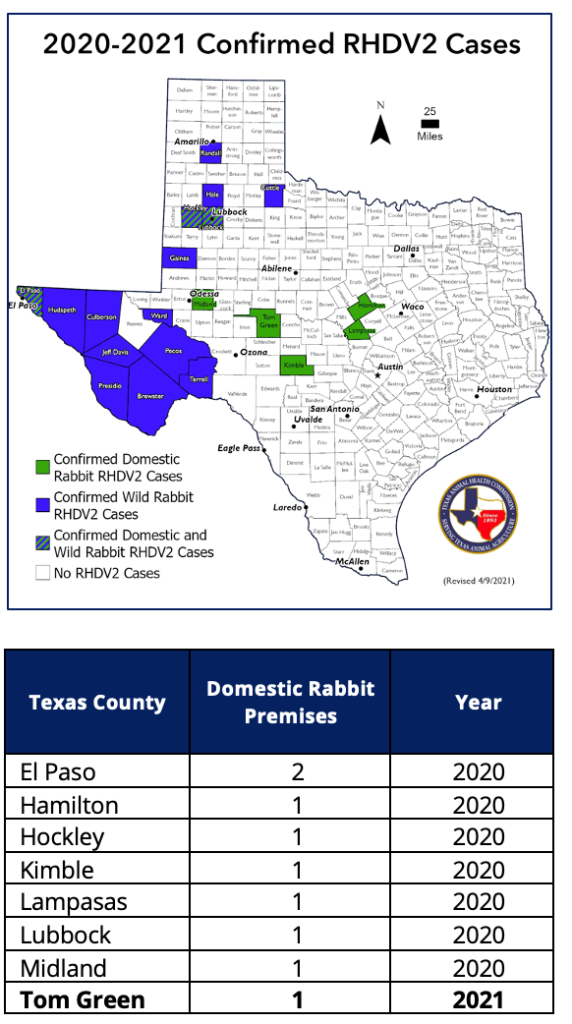Source: Texas Animal Health Commission | April 9, 2021
The Texas Animal Health Commission (TAHC) received confirmation of rabbit hemorrhagic disease virus serotype 2 (RHDV2) in domestic rabbits on a Tom Green County premises on March 5, 2021. This is the first positive case of RHDV2 in Texas this year.
The rabbits were tested after sudden death loss was observed and reported to a local veterinarian who submitted samples to Texas A&M Veterinary Medical Diagnostic Laboratory (TVMDL) with later confirmation by the National Veterinary Services Laboratory in Ames, Iowa.
RHDV2 is a fatal, viral disease that affects both domestic and wild rabbits, including hares, jackrabbits and cottontails. It does not affect humans, or other animal species.
There is a preventative vaccine available, and Texas veterinarians have succeeded in securing the vaccine for use in domestic rabbits. Rabbit owners should contact their private veterinarian to coordinate vaccine procurement and utilization.
“The TAHC would like to remind all rabbit owners and breeders to continue robust biosecurity practices on their farms and in their homes, whether they choose to vaccinate or not,” said Dr. Andy Schwartz, State Veterinarian and TAHC executive director.
RHDV2 was first discovered in domestic Texas rabbits in April 2020, with later confirmations in El Paso, Hamilton, Hockley, Kimble, Lampasas, Lubbock and Midland counties.
This highly contagious foreign animal disease spreads between rabbits through contact with infected rabbits or carcasses, their meat or fur, or contact with contaminated food, water, or materials. RHDV2 can persist in the environment for a very long time. These factors make disease control efforts extremely challenging once it is in the wild rabbit populations.
The Texas Parks and Wildlife Department has confirmed RHDV2 in the wild rabbit population of Brewster, Cottle, Culberson, El Paso, Gaines, Hale, Hockley, Hudspeth, Jeff Davis, Lubbock, Pecos, Presidio, Randall, Terrell, and Ward counties. If sick or dead wild rabbits are noticed, a local TPWD wildlife biologist should be contacted. To learn more about RHDV2 in wild rabbits, visit the TPWD website.
Rabbit owners who observe high fever, poor appetite, depression, inactivity, bloody discharges, and/or sudden death in most or all of their rabbits should call their private veterinarian right away. Only laboratory tests can confirm RHDV2 for sure. Private veterinarians are requested to contact the USDA-APHIS or the TAHC to report any suspected cases at 1-800-550-8242. Report all unusual mass morbidity (sickness) or mortality (deaths) events to the TAHC.
Protecting Your Rabbits with Biosecurity
The following procedures can reduce the chance of RHDV2 and other contagious diseases from affecting domestic rabbits. For a printable version, click here.
- House rabbits indoors if possible.
- Do not allow pet, feral, or wild rabbits to come in contact with your rabbits or gain entry to the facility or home.
- Always wash your hands with warm, soapy water between pens and before and after entering your rabbit area.
- Keep a closed rabbitry. Do not introduce new rabbits from unknown or untrusted sources. If you bring new rabbits into your facility or home, keep them separated from your existing rabbits. Use separate equipment for newly acquired or sick rabbits to avoid spreading disease.
- Control flies, rats, cats, dogs, birds, etc. that can physically move the virus around on their feet or body.
- Do not collect outdoor forage to feed rabbits since it may be contaminated.
- Remove brush, grass, weeds, trash, and debris from the rabbitry to reduce rodents.
- Protect feed from contamination by flies, birds, rodents, etc.
- Remove and properly dispose (i.e. bury or incinerate) of dead rabbits promptly.
- When moving rabbits or restocking pens, disinfect all equipment and cages with 10% bleach mixed with water or other approved products. Properly dispose of bedding. Items made of wood are difficult to disinfect and best discarded.
- Breeders should review their biosecurity plans for gaps, and all rabbit owners should establish a working relationship with a veterinarian to review biosecurity practices for identification and closure of possible gaps.
Visit https://www.tahc.texas.gov/animal_health/rabbits/ for more information and resources on rabbit hemorrhagic disease.
The TAHC will post future domestic RHDV2 cases on the agency website at https://www.tahc.texas.gov/animal_health/rabbits/. To receive updates, subscribe to the rabbit email distribution list here.

